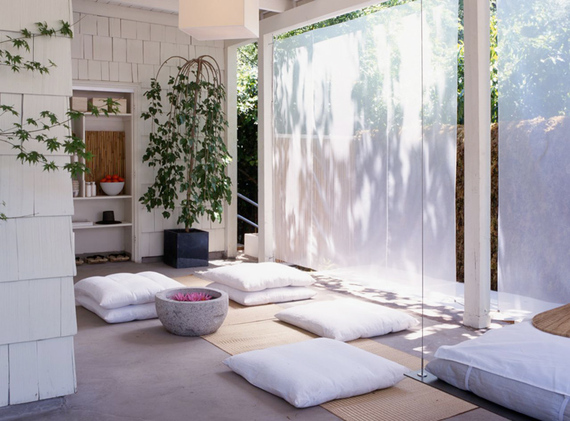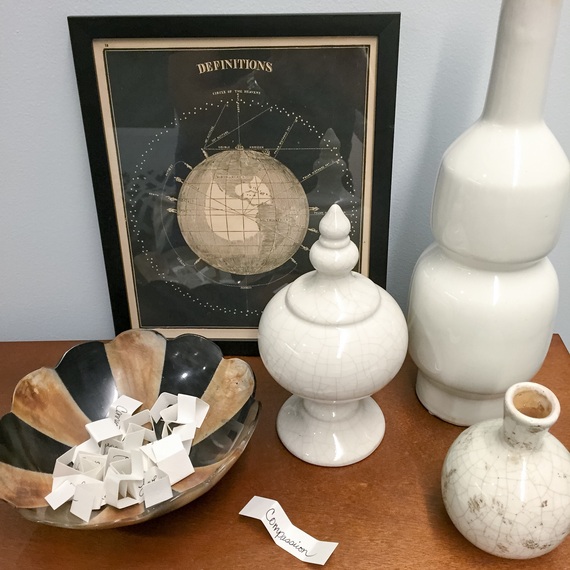Having a designated space for spiritual practice, whether it be yoga or meditation, creates an atmosphere that allows your spiritual life to thrive. It encourages your practice and establishes consistency, which is the key to strengthening your muscle of awareness. Every time you are seated in this space, it sets a tone that promotes presence and a deliberate focus of your attention.
The Space
Ideally, you want a space that is free from distraction and out of public view. A bedroom corner can work nicely, for example. Another element to consider is the color of the space -- scientific studies have yielded useful information about the way color influences our mood. So, when making color choices, consider blues, greens, light purples, and soft pinks as they have been shown to have a soothing effect. It may also be helpful to look at natural landscapes for palette inspiration. As far as colors to avoid, steer clear of bold or vibrant tones, as they can be overly stimulating. No matter what you color you choose, take time to experiment -- make your space personal and discover what truly works for you.
Sitting
Have a floor cushion, seat, or folded blanket to support your posture while sitting. Avoid the temptation to lie down, if possible. Often times, people will unintentionally fall asleep -- a nap is not the same as meditation. By maintaining a place on the floor that promotes proper posture, you can create a healthy habit of avoiding positions that do not serve your practice.
Lighting
I am not a fan of overhead lighting, especially in a meditation space. Instead, make use of indirect lighting from a lamp or sconce. Candles are another great option, as they can add a spirit of ceremony to your practice.
Altar
Use a small table or chest to serve as an altar -- a space to place objects of importance to you. Incorporate symbols and teachers of your preferred religious practice, if you have one. You can also make use of personal items that hold spiritual significance for you. These objects should lift your spirits and promote a sense of connection. I, for example, have a bowl filled with treasures that I've collected over the years. It showcases shells, crystals, stones, feathers, beads, tokens -- all things that hold meaning to me.
Engage the Senses
When creating your space, consider all five of the senses. Add your favorite flowers or plants -- even a bowl of fruit can complement the space. Hang art or images that bring you joy. Light your favorite scented candle, incense, or essential oil diffuser. When it comes to sound, I prefer silence. Though, at times, I will incorporate music into my meditations as it can heighten connection and shift the energy in the room.
Meditation Starters
I like to mix up my meditations. Sometimes I sit quietly, focusing on the breath -- other times, I use myPrimordial Sound Mantra. Now and then, I go in with a specific idea or thought and will meditate on that. For example, you can create an "intention bowl" by writing out single words such as love, gratitude, compassion, forgiveness, etc. on strips of paper and placing them into the bowl. Before beginning your meditation, pull out a random strip of paper and let that word serve as your mantra for the practice. Or you can use the intention bowl after your meditation; using the word you draw as your intention for the day. If writing out intentions doesn't suit you, consider grabbing one of the many wonderful card decks out there, such as Danielle Laporte's Truthbomb series, or Gabrielle Bernstein's Miracles Now deck. Also, keep a journal close by so you can free-write after meditation, recording your insights and promoting further guidance.
Spirituality is the path to the heart. Make it a priority by creating a special space that supports your conscious contact with your true self. With a bit of effort, your home can become your sanctuary; a place of refuge from the hectic nature of life. Take time to incorporate elements that you find beautiful, or as one of my client says, "Oooh, that makes me happy!" Things that evoke that reaction are the things that speak to the soul.
For more inspiration on connecting home and spirit, be sure to check out www.conscioushome.com.

